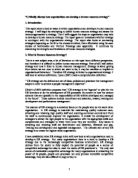Touro University International
Kevin P. Beck
BUS 401 - International Business
Module 3 Case Assignment: Molex's Global Human Resource Management Strategy
Professor - Dr. Paul Watkins
Molex's early decision to align its global human resource management (HRM) strategy with its international business structure was the single most important factor taken toward successfully managing its diverse, widespread workforce. According to its website, Molex operates 55 manufacturing facilities in 19 countries and has 18,000 employees in 115 locations around the globe. Furthermore, the company's operations outside the Americas generate approximately 60 percent of its total sales. This paper will demonstrate how Molex combines host country HR expertise with company-wide HRM standards and clear communication to remain profitable while keeping its employees focused and motivated.
A key part of Molex's HRM strategy is to employ host-country human resource (HR) experts. This polycentric approach to HRM helps the company gain acceptance as an integral part of the host country and acts to subdue the "foreign company" image many global companies contend with outside their home countries. Another benefit is local national HRM managers are often informal leaders in the community and they know the laws, customs, culture and the language. According to Malou Roth, Molex's former vice president of corporate training and development, it's relatively easy to send someone from the home country to oversee technical operations overseas, which are typically more standardized. But it's viewed as a more difficult task to export people who know how to effectively recruit and manage local talent. That's where the company's policy of hiring host country HR experts enters the picture. Additionally, the costs involved with an expatriate HR workforce can range from two to five times an employee's annual base salary. Molex's use of locally hired personnel experts further serves to reduce the cost of transferring expatriate HR specialists from the home country to another. But how does the company meld geographically separated employees from different cultures into a coherent team?







